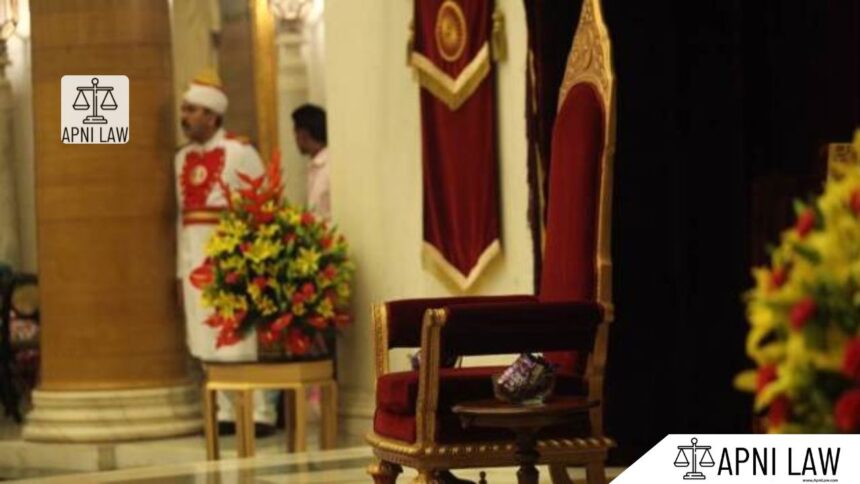The Indian Constitution provides a balance between the legislature, executive, and judiciary. One of the unique features is the ordinance-making power of the President under Article 123. This provision allows the executive to step into the shoes of the legislature in urgent situations. The framers of the Constitution introduced this power to deal with extraordinary circumstances when Parliament is not in session and immediate law-making becomes necessary.
Article 123 authorizes the President to promulgate ordinances that carry the same force and effect as an Act of Parliament. However, this power is temporary, conditional, and subject to judicial and parliamentary control. The President does not exercise this authority independently but only on the advice of the Council of Ministers headed by the Prime Minister.
This mechanism has often been debated in Indian constitutional law because it grants law-making powers to the executive, something that most democratic constitutions, like those of the United States and the United Kingdom, do not permit. To understand its scope, effect, and limits, it is essential to examine Article 123 in detail.
What Does Article 123 Provide?
Article 123 empowers the President to issue an ordinance when one or both Houses of Parliament are not in session. The condition precedent is that immediate action is required and Parliament cannot pass a law in time. The ordinance carries the same authority as an Act of Parliament but remains temporary in nature.
This provision was borrowed from the Government of India Act, 1935, where the Governor-General had similar powers. The Constituent Assembly debated its scope extensively. Members like K.T. Shah expressed concerns about misuse, while others defended it as a necessary emergency tool. Finally, the Assembly retained the provision but inserted safeguards to ensure accountability.
How Does an Ordinance Operate?
An ordinance issued by the President takes effect immediately upon promulgation. It remains valid for a maximum of six weeks after Parliament reassembles unless both Houses approve it through a resolution. If Parliament disapproves it earlier, the ordinance ceases to operate instantly.
The ordinance can introduce a new law, amend an existing law, or repeal any law that Parliament itself could deal with. However, it cannot amend the Constitution, as that power rests exclusively with Parliament under Article 368. The ordinance can even have retrospective effect, meaning it can apply to a date before its promulgation.
Importantly, all actions taken under an ordinance remain valid even after it lapses or is rejected, which ensures continuity and prevents legal vacuum.
What Are the Constitutional Safeguards?
The ordinance-making power is not absolute. Several safeguards restrict its use. First, the condition that Parliament must not be in session acts as a key limitation. If both Houses are in session, the President cannot issue an ordinance.
Second, the duration of an ordinance is temporary. It automatically ceases after six weeks from the date Parliament reassembles unless approved. This ensures that ordinances remain a stopgap measure and not a substitute for regular legislation.
Third, the satisfaction of the President to promulgate an ordinance is justiciable. Earlier, courts treated it as beyond judicial review, but later judgments allowed challenges if the ordinance was issued in bad faith or for extraneous reasons. The 44th Constitutional Amendment (1978) clarified that judicial scrutiny is permitted.
Can the President Issue an Ordinance at Personal Discretion?
The President cannot use this power at personal discretion. The Constitution makes it clear that the President acts on the advice of the Council of Ministers under Article 74. This ensures that the ordinance reflects the collective decision of the elected government and not the personal will of the President.
Thus, the real decision-making lies with the Cabinet, and the President only formalizes it. This is consistent with the parliamentary form of government where the executive is accountable to the legislature.
What Are the Judicial Pronouncements on Ordinances?
Indian courts have played a crucial role in defining the limits of ordinance-making power. In R.C. Cooper v. Union of India (1970), the Supreme Court held that the President’s satisfaction is subject to judicial review. Courts can strike down an ordinance if it is mala fide or amounts to misuse of power.
In the landmark D.C. Wadhwa v. State of Bihar (1987) case, the Supreme Court strongly criticized the practice of re-promulgating ordinances without placing them before the legislature. The Court declared continual re-promulgation unconstitutional as it violates legislative supremacy.
These decisions highlight that ordinances are meant for temporary and urgent use, not as a parallel law-making mechanism.
Can Ordinances Violate Fundamental Rights?
Ordinances must conform to constitutional provisions, including Fundamental Rights. If an ordinance infringes rights under Part III of the Constitution, courts can strike it down. For example, an ordinance cannot impose unreasonable restrictions on freedoms under Article 19 or encroach on matters reserved for the States.
This restriction ensures that the executive cannot bypass constitutional safeguards by issuing ordinances. It also prevents misuse of power in areas where Parliament itself has no authority.
How Do Ordinances Compare With Acts of Parliament?
An ordinance has the same force and effect as an Act of Parliament, but the difference lies in its temporary character. While Acts of Parliament remain permanent until repealed, ordinances lapse unless approved within the stipulated time.
Acts undergo debate and scrutiny in both Houses, while ordinances bypass such deliberation. This raises concerns about democratic accountability. Therefore, ordinances are often described as executive legislation, a substitute only in emergencies, not in normal circumstances.
What Is the Practice of Re-Promulgation?
Re-promulgation refers to the repeated issue of the same ordinance without placing it before Parliament. Several governments in India used this practice to continue laws without legislative approval. The Supreme Court in D.C. Wadhwa condemned this as unconstitutional, as it undermines Parliament’s authority and violates democratic principles.
Despite this judgment, instances of re-promulgation have occurred. Critics argue that this amounts to executive overreach and weakens the role of Parliament. The practice remains a matter of constitutional debate and judicial scrutiny.
How Is India Different From Other Democracies?
Most democracies, including the USA and UK, do not grant such law-making powers to the executive. Their constitutions emphasize strict separation of powers. In contrast, India provides this mechanism as an emergency tool due to the need for swift legislative action in a vast and diverse country.
This reflects the pragmatic approach of the Indian Constitution, which blends parliamentary supremacy with executive flexibility. However, checks like judicial review and limited duration prevent abuse.
What Are the Implications of Ordinance-Making Power?
The ordinance-making power plays a vital role in India’s governance. It allows the government to respond quickly to urgent matters, such as economic reforms, social welfare, or unforeseen crises. For example, governments have used ordinances for land reforms, financial measures, and even during the COVID-19 pandemic.
At the same time, overuse or misuse of this power threatens parliamentary democracy. Frequent ordinances bypass debate and weaken legislative scrutiny. The judiciary has intervened to check abuse, but political accountability remains the key safeguard.
For any specific query call at +91 – 8569843472
Conclusion
Article 123 of the Indian Constitution equips the President with a special law-making power during parliamentary recess. This authority acts as a safety valve in urgent situations, ensuring governance continues without disruption. However, it is temporary, subject to approval by Parliament, and open to judicial review.
The framers of the Constitution designed this power to balance executive efficiency with democratic accountability. Its misuse through re-promulgation or excessive reliance undermines parliamentary supremacy. Therefore, while ordinances remain an essential constitutional tool, their use must remain rare, justified, and temporary.
In sum, Article 123 reflects the flexibility of the Indian Constitution. It grants the executive power to act swiftly in emergencies but ensures that Parliament retains ultimate control over law-making.








